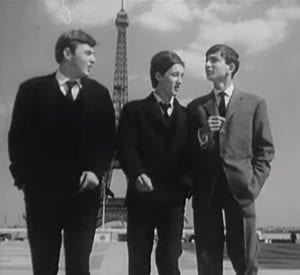
My uncle from Oldham near Manchester had danced to rock’n’roll in his teens in the early-to-mid 1950s and on his many travels through Europe during the 1960s (he had by then become a university physics lecturer) he was left with the distinct impression that there existed no youth culture in France or anywhere else in Western Europe, not compared to England at any rate. Nevertheless, the first stirrings of such a music-oriented subculture had begun to rear its head in France in the summer of 1959 with the appearance of the much feared working-class leather-jacketed Blousons Noirs (‘black jackets’). It’s interesting to see that that same year the sartorial style of the Parisian youth was described quite differently in a newsreel reportage. From a British perspective, imagine a parallel 1950s world in which rock’n’roll had not broken out and was only of interest to small ‘underground’ groups of avant-garde individuals in some major cities of the country.
For someone interested in finding rock’n’roll and American influences, the film is underwhelming. The word rock’n’roll is mentioned only once as one type of music enjoyed by youth alongside the cha-cha and … classical music. The youth depicted here are from the well-heeled portion of the Parisian population.
Le style des jeunes Parisiens “des beaux quartiers” & “des enfants gâtés de la bourgeoisie parisienne” (YTcomms 2019)
The same set of youth is portrayed in Marcel Carné’s film Les Tricheurs (‘The Cheaters’) which had its premiere on the 10th October 1958 before gaining an award. The film chronicled the life of a group of well-heeled Parisians qui vivent entre rive gauche de Saint-Germain-des-Prés et rive droite du 16e arrondissement de Paris.
The protagonist Pour le jeune homme, « tout » a commencé avec la rencontre, chez un disquaire, d’Alain qui, ayant abandonné Normale Sup, vit dans la bohème, aux crochets de son entourage, fils de famille ou autres. Alain emmène Bob au Bonaparte, café de Saint-Germain-des-Prés et quartier général d’une bande de plus ou moins jeunes oisifs, avec lesquels l’étudiant BCBG va se lier, dont Clo et surtout Mic.
Bob tombe amoureux de Mic et vice-versa. Seulement c’est, pour la bande qu’ils fréquentent, un sentiment si petit-bourgeois, si « ridicule » qu’aucun des deux n’ose l’avouer franchement. À soi-même, à la personne aimée, au cercle rapproché des potes devant qui il est tellement plus facile de mentir, de tricher, sauf que… ça peut très mal finir.
Things had not changed so much in 1963 …
Post Comment